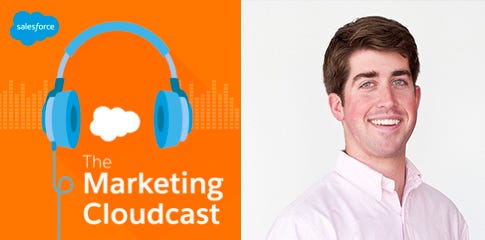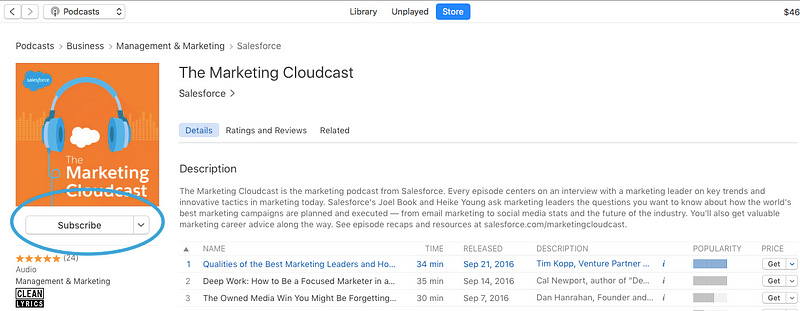Marketers talk about mobile as the future of marketing all the time. We fully acknowledge that customers carry their smartphones with them everywhere; that mobile devicesA�drive more trafficA�to websites than desktops; and that mobile owns a greater portion ofA�email open rates.
Yet many mobile marketing channelsa�Sa��a�Sfor instance, SMS or text-message marketinga�Sa��a�Sare highly underutilized despite the popularity of mobile.
With almost every consumer wielding a supercomputer during their waking hours, what can marketers do to get the most out of mobile technology, especially when it comes to the emerging area of text-message marketing?
On this weeka��s episode ofA�the Marketing Cloudcasta�Sa��a�Sthe marketing podcast from Salesforcea�Sa��a�Swea��re shedding light on SMS marketing and how organizations can incorporate mobile more proactively into the mix. We interviewed Greg Murphy, Salesforce Mobile Product Manager, for the complete low-down.

If youa��re not yet a podcast subscriber, check out the Marketing Cloudcast onA�iTunes,A�Google Play Music, orA�Stitcher.
Take a listen to our conversation with Greg here:
You shouldA�subscribeA�for the full episode, but here are a few takeaways from this podcast episode about SMS marketing.
1. SMS has an open rate of 98% and a conversion rate ofA�45%.
The numbers dona��t lie. a�?Brands that are actively running programs on the SMS channel are highly aware of that open rate, and thata��s driven by the ROI coming back from this channel,a�? says Greg.
No email marketing campaign will ever see an open rate near 98%. Similarly, with all the algorithms and factors that affect which social media messages are seen, you can bet that none of your social messages will ever be read by 98% of all your social fans and followers. That makes SMS special.
2. 90% of text messages are opened within 3 minutes of being received.
Want to send an SMS? Know that 90% of texts are opened within 3 minutes of being receiveda�Sa��a�Smeaning SMS marketing is a�?a highly disruptive channel, but a hugely positive disruption for the end user and the brand,a�? explains Greg.
Retailers especially are seeing impressive ROI from text messages, which result in quick opens and direct responses from consumers in short order.
3. Millennials are keen to engage with companies through mobile messaging.
Greg says that millennial consumers are highly aware of marketing and being marketed to. He points out, a�?They know what information they want, and theya��d like to gain access to that in an organic way.a�? This means giving younger customers the opportunity to converse back and forth with your brand on the channel thata��s easiest for them: mobile. a�?Thata��s whata��s best for them because thata��s what theya��re used to,a�? Greg shares.
These mobile interactions could take the form of SMS and MMS (text messages including multimedia like pictures) or push notifications and in-app messages. When it comes to mobile, you have a lot of options. Greg says mobile messaging is an a�?extremely strong channel for bringing users back into your app.a�? Increasingly, companies are also communicating with customers through Facebook chat, WhatsApp, and other short-form mobile methods, which a�?is really a testament to how users expect to interact with a brand,a�? says Greg.
4. For an awesome SMS program, think useful, not just promotional.
a�?Therea��sA�a�� strong capabilities and proven use cases through the texting channel. Marketers have found success with this channel, but therea��s also a huge breadth in capabilities and use cases,a�? says Greg. To have a truly successful SMS program, think about more than just marketing.
Instead of simply sending promotional texts, Greg encourages users to think out of the box. a�?Do you want an SMS message when your table is ready at a restaurant? Do you want an SMS when your Uber has arrived? Do you want an SMS when your package has shipped? These one-time messages are very valuable for the brand and the user,a�? he shares.
5. The disruption of SMS makes it both valuable and a little dangerous.
The simple fact that text messages are so disruptive is what makes them uniquely useful. a�?Theya��re going to pull the customer away from what theya��re doing and demand attention to your brand. This is what really positions the channel for your branda��s specific mobile moment,a�? advises Greg.
The trick to getting the mobile moment right? Being selective and communicating minimally. Greg encourages marketers to ask, a�?Does this marketing message warrant interrupting someonea��s dinner?a�? If the answer is no, ita��s probably better to send it through another channel. After all, unsubscribing is simple on SMS, and despite the best personalization tactics, you never truly know the time zone, circumstance, or mood of the person on the other end of a text.

6. The state of marketing today isA�mobile.
Mobile defines marketing today more than anything else. Mobile is where we experience the majority of marketinga�Sa��a�Sand ita��s the lens through which we view every marketing message. a�?Marketers need to keep that at the top of mind,a�? says Greg.
So how can marketers get creative with mobile? It all starts with that initial moment of need. a�?Customers have a high expectation that your brand is available to them in that moment of need and that they are going to be able to reach you.a�?
Marketers need to make these mobile moments happen. a�?If youa��re not doing that, your competitors are,a�? says Greg.
And thata��s just scratching the surface of our conversation with Greg Murphy. Youa��ll learn much more about implementing a new SMS program, or making tweaks to an existing program, in this episode of the Cloudcast.
Join the thousands of smart marketers who already subscribe onA�iTunes,A�Google Play Music, andA�Stitcher.
New to podcast subscriptions in iTunes? Search for a�?Marketing Cloudcasta�? in the iTunes Store and hit Subscribe, as shown below.

Tweet @youngheikeA�with marketing questions or topics youa��d like to see covered next on the Marketing Cloudcast.
Originally published atA�www.salesforce.com.
